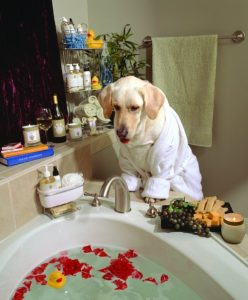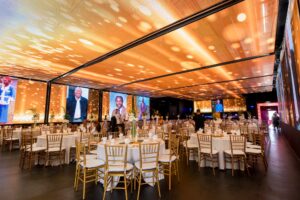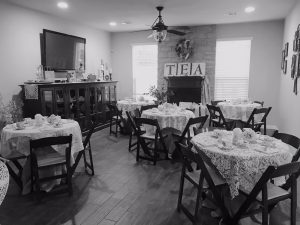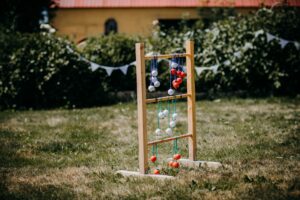If you’re looking for trade show booth ideas that actually bring people into your booth, you’ve come to the right place!
Trade shows offer a valuable chance to connect with potential buyers, but making your booth memorable doesn’t have to cost a fortune. After years of experience exhibiting at events across the U.S. and Europe (and winning “Best Booth” at several), the Reventals team has learned what works.
Here are five trade show booth ideas that help you get noticed, engage customers, and make the most of your investment. We’ll also dive into a few more tips you can use to build an eye-catching booth.
- How to Make Your Trade Show Booth Stand Out
- Trade Show Booth Ideas
- How to Set Up a Booth at a Trade Show
- What to Bring to a Trade Show Booth
How to Make Your Trade Show Booth Stand Out
Most trade show booths blur together. Visitors make snap judgments from 10–15 feet away. If it’s not immediately clear what you offer, they’ll keep walking. Booths that stand out lead with clarity—not clever taglines or cluttered signage.
A common mistake is trying to show everything at once. But more choices often lead to fewer decisions. A well-curated booth feels easier to approach. That sense of ease encourages people to step in and start a conversation.
- Focus on one or two standout products. Highlight your most popular or visually interesting items. Keep supporting material nearby, but let your top products do the heavy lifting.
- Build trust at a glance. Visitors look for signs that your brand is credible and established. Display awards, press mentions, and customer logos. If you have testimonials, show them—on a screen, on a sign, or even on product displays. A few lines of social proof can help start a conversation before your team says a word.
- And above all—be human. A polished booth might get attention, but the real impact comes from your team. Make sure they’re standing, smiling, and ready to engage. Don’t sit behind a table. Don’t wait for people to approach. Greet visitors warmly and give them a reason to stick around.
People may forget the booth itself. But they’ll remember how it felt to be there and how your team made them feel.
Trade Show Booth Ideas
Reventals and our sister company TapGoods have spent years attending trade shows across the U.S. Along the way, we’ve seen what makes a booth successful and what makes it forgettable.
Below are practical trade show booth ideas that help you attract attention and start real conversations.
Trade Show Booth Idea #1: Let Your Product Inspire the Design
Your booth should clearly communicate what you offer without needing much explanation. One of the best ways to do that is to make your product the theme. Everything from the visuals to the layout to the props should reflect what you sell.
For example, a dog bath product company transformed its booth into a mini spa. Oversized images of dogs in bathtubs lined the walls. Shelves were styled with rolled towels and candles, echoing the relaxing, clean feeling their products offered. It didn’t just look nice—it helped buyers immediately understand the product line.
To apply this to your booth:
-
Choose 1–2 core ideas that reflect your product. This could be a feeling (luxury, fun, natural) or a setting (kitchen, spa, workshop).
-
Use large visuals to tell the story. Skip long text. One or two high-quality images will say more than a brochure wall ever could.
-
Add small props to bring the theme to life. Think about textures, materials, and lighting that match your brand. If you sell eco-friendly goods, natural wood, greenery, or soft neutral tones could help reinforce that message.
-
Keep the setup simple. Don’t overload the space. Aim for clarity, not clutter.
Your goal is to create a space that feels intentional and familiar. When someone walks by, they should be able to tell what you do—and want to know more.
Trade Show Booth Idea #2: Use Furniture and Props that Feel Natural
Standard trade show booths often rely on pop-up banners and podiums. While convenient, they tend to blend in with everything else on the floor.
Instead of going the traditional route, consider using real furniture and props that match the look and feel of your brand. One Reventals client used inexpensive shelving from Ikea and styled it with a few on-theme pieces. The space felt more like a boutique than a standard trade show setup—and it stood out in a row of nearly identical booths.
To apply this idea to your own booth:
-
Use furniture to shape the space. A small café table can turn a product demo into a conversation. A lounge chair or soft bench invites people to slow down. Items like this can help break the “walk and glance” pattern common at trade shows.
-
Match materials to your brand. A tech brand might go for sleek, modern pieces with metal or acrylic finishes. A natural wellness brand might lean toward wood, linen, or neutral tones.
-
Bring in functional décor. Use props that aren’t just for show. Trays, baskets, or stands can help display your products while reinforcing the overall look.
-
Rent strategically. Renting larger pieces like backdrops, bar-height tables, or stools can save time and money—especially if you’re flying to the show or want to avoid shipping costs.
This approach often costs less, too. Many pop-up booths run around $1,200 once you factor in graphics and shipping. A setup using rented or budget-friendly furniture can often come in lower—and look more custom.
Want help finding rentals that match your brand’s style? Reventals can help you source exactly what you need based on the city and date of your show.
Trade Show Booth Idea #3: Create Opportunities for Interaction
booth should do more than display your products. It should invite people to engage. Interaction creates a reason to stop, spend time, and start a conversation—something printed banners alone can’t do.
At one show, a brand offered free samples but with a twist. Attendees were invited into the booth to smell each product scent and choose a favorite to take home. It turned a passive handout into a moment of connection. While customers explored, the team shared product benefits in a relaxed, conversational way.
Here are a few ways to bring interaction into your booth:
-
Let customers try or test your product. A demo station, smell bar, or sample table adds interest and encourages questions.
-
Add a tactile element. Even if you don’t offer samples, you can display raw materials, textures, or packaging that visitors can touch and explore.
-
Offer something to take away. Samples, mini guides, or branded swag work well—especially when paired with a short conversation.
-
Use signage to invite interaction. A simple callout like “Pick your favorite,” “Smell before you decide,” or “Try it here” gives attendees a reason to stop.
The goal isn’t just to hand out materials—it’s to make people feel welcome and involved. When they participate, they’re more likely to remember your booth and your brand.
Trade Show Booth Idea #4: Match Your Team’s Look to the Theme
Coordinated outfits help create a more professional presence and show attention to detail, which makes a lasting impression.
Think about what visual style supports your product or brand:
-
Selling spa or wellness products? Robes, soft colors, or clean uniform lines reinforce the vibe.
-
Showcasing food or beverages? Aprons or branded chef coats work well.
-
Representing a tech or startup brand? Matching polos or tees in your brand colors keep things casual but consistent.
Uniforms don’t need to be expensive. The goal is to create visual consistency that ties into your booth’s overall feel. That small effort can make your team look more approachable and helps the booth feel like a fully thought-out space.
Trade shows are packed with distractions. Clear branding—even in team attire—helps your booth stand out and feel more put-together at a glance.
How to Set Up a Trade Show Booth
Booth setup starts long before you arrive at the venue. A solid plan helps avoid last-minute problems and makes sure your booth feels polished, not pieced together. Here’s how to set up your booth for a smooth, professional presence:
1. Get the Specs
Before designing anything, confirm these details with the event organizer:
-
Booth dimensions (including height limits)
-
Power access and outlet locations
-
Restrictions on third-party rentals or materials
-
Flooring type (so you can plan for rugs, flooring, or stability)
Knowing these in advance will help you avoid surprises and wasted spending.
2. Design the Layout Around Flow
Plan for how people will enter and move through your booth.
Do this:
-
Keep the front open; avoid placing tables or signs across the entry line.
-
Use furniture or rugs to define different zones (demo area, conversation space, product displays).
-
Leave enough space for at least 2–3 people to comfortably browse at the same time.
Don’t do this: Set up like a store counter where your team is on one side and attendees are on the other. That setup discourages engagement.
3. Prep Signage and Displays in Advance
Every item in your booth should be intentional and brand-aligned.
What to prepare:
-
One large visual or phrase that quickly explains what you offer
-
Product signage with 1–2 clear benefit statements (keep copy short)
-
Company name and logo placed high enough to be seen from a distance
-
Any testimonial or award signage you plan to use (don’t leave this to the last minute)
Print materials should be clean, durable, and able to survive setup, takedown, and travel.
4. Pack Smart and Label Everything
Trade show setups move quickly. Being organized saves hours.
Tips:
-
Pack by zone: group items based on where they’ll be placed in the booth
-
Label cables, chargers, and power strips
-
Bring a printed layout photo to speed up the setup process
-
Include extras: gaffer tape, scissors, pens, hand wipes, phone chargers, and a power strip
Pro tip: Pack a small step stool if your booth requires elevated signage or shelving.
5. Arrive Early and Build Efficiently
Give yourself more time than you think you need.
How to stay on track:
-
Arrive when setup opens, not an hour before the show starts
-
Start with the anchor pieces—backdrops, tables, and shelving—then fill in the rest
-
Plug in and test all lights and electronics early, while help is still available
-
Keep packaging and storage items hidden or tucked behind your backdrop
Don’t forget to assign one team member to walk the floor briefly and see how your booth looks from a distance.
What to Bring to a Trade Show Booth
Here’s what to bring and what you should consider renting instead of hauling.
Booth Essentials
These are the core items every exhibitor should have on hand:
-
Product samples or demo units
-
Branded signage and display stands
-
Business cards, flyers, or QR codes
-
Power strips, extension cords, and chargers
-
Hand sanitizer, wipes, and basic cleaning supplies
-
Tape, scissors, pens, and zip ties
-
A small tool kit (screwdriver, utility knife, Velcro)
-
A printed booth layout or setup guide
Don’t Forget the Rentals
Many trade show venues offer basic booth packages—but they’re often expensive and limited in style. Renting from a third-party provider like Reventals gives you more options and helps your booth stand out.
Consider renting:
Renting is especially helpful if you’re flying in or want to avoid shipping heavy items. Just show up and we’ll have your rentals ready to go. Need help picking the right rentals? Reventals can help you choose items that match your brand and meet your budget. Just tell us the city and date, and we’ll take care of the rest.
We Hope You Liked These Trade Show Booth Ideas! Ready to Get Started?
A well-designed booth can make all the difference at your next event. From clear signage to inviting layouts and on-brand furniture, the right setup helps you attract more attention and have better conversations.
If you’re ready to take the next step, Reventals can help. We’ll source the tables, chairs, backdrops, and display pieces you need—so you can focus on connecting with attendees and growing your business.
Explore our full online rental marketplace here!














